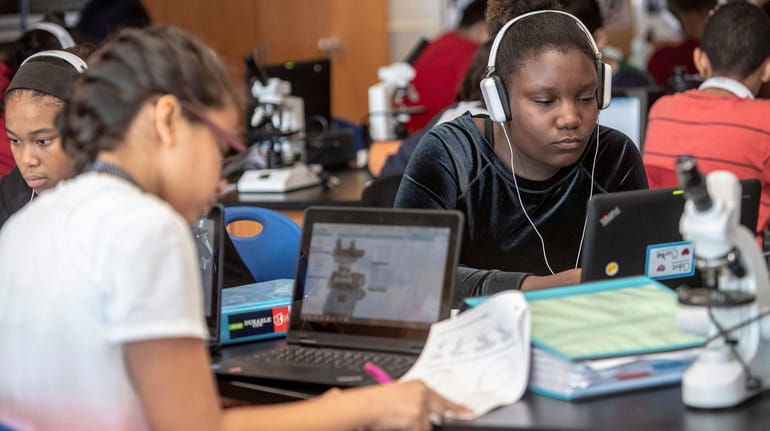The Point: NY portal maps lack of computers, internet access

Students in Freeport use Chromebooks while working on assignments in 2018. Credit: Newsday/J. Conrad Williams Jr.
When COVID struck the United States in March 2020, and schools sent all their students home to learn, a widespread shortcoming moved from the back burner to the fore: Many households across the nation and in New York lacked access to computer devices, or the internet, or both.
That meant many students who were supposed to be getting home-schooled by their districts couldn’t properly participate.
It also meant many of those children had faced a tough road to studying at home even before the pandemic, and might continue to when it has passed.
Tuesday, a consortium that includes Cornell University and the State Education Department launched a web portal mapping the state that will show, by census tract, the percentage of households in a given area that have access to computer devices and internet, along with some other details.
The portal has some very interesting ways of slicing and dicing data.
Statewide, for instance, 13.9% lack internet at home and 4.3% lack a computer device. On Long Island the numbers are worst in the 1st Congressional District, with 10% lacking internet access and 3.4% lacking a computer device. The numbers are best in the 3rd Congressional District, where 7.4% have no internet and 0.8% have no computer device.
Users can also chop that data by county, State Senate or Assembly district, library system, town, city or ZIP code.
But there are weird data skews and imperfect claims.
In the color coding of the system, dark green means nearly every household has internet and computers, and tending toward light yellow signals a serious lack, with bright red saved for the worst areas.
In a bright-red South Shore Suffolk tract the portal says 30% of households have no computer and 19% have no internet.
But since the tract is identified as Water Mill, a community that includes the 14th most expensive ZIP code in the nation, it seems likely some interpretation has come into play.
And speaking of interpretations, an asterisk that pops up regularly will have all the old Compuserve, AOL, Friendster and Hotmail fans up in arms. It explains that the category "% with no Internet at home" includes "households and persons with dial-up services only."

